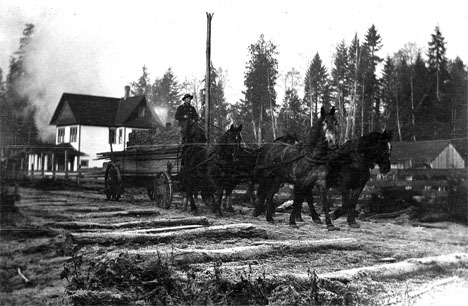Francis M. Sherman, who was the son of early Vashon settlers Salmon and Eliza Sherman, built the Sherman House in 1904 and in 1911 in two stages — the one-story back part of the house on S.W. 204th Street was built first, and the two-story front part was completed seven years later.
Sherman moved his steam lumber mill from its original location on Cemetery Road after he logged the original property. Paradise Valley was heavily timbered at the time Francis bought the property, and he logged most of the nearby timber and built the family home east of his mill.
Once the land was cleared, Sherman developed the area into a farm. He sold the property in 1936 and moved to the family’s summer home on land his grandfather C.C. Sherman had homesteaded on Quartermaster Harbor in 1880. The lumber mill was located to the west of the Paradise Valley house and, in the original photograph, steam can be seen rising behind the house from the mill boilers.
The steam mill had two boilers: one for the head saw, which cut logs into dimensional lumber, and the other for the planers, shapers and other mill needs. In addition, the mill had an acetylene generator that produced acetylene to light the mill and the house. Sherman was awarded the contract for dimension lumber to build Luna Park, the famous amusement park that opened in 1907 and was located along the south shore of Elliott Bay in West Seattle.
To save time in delivering lumber to the dock at Ellisport, Sherman purchased the right-of-way property, constructed the road between what is today 107th Avenue S.W. and Vashon Highway, and then gifted the road to King County. The original road ran east from Paradise Valley (today’s S.W. 204th Street), turned north at 107th Avenue S.W. and then east on Cemetery Road. Extending S.W. 204th Street to Vashon Highway saved nearly two miles on the trip from the mill to Ellisport.
The small barn on the right of the original photograph was built along with the house in 1904. A new barn was built in the field east of the house in 1910 and later became known as “The Jesus Barn.” The old barn was used as a garage and workshop until it was demolished in 1934. During the early 1970s, the word “Jesus” was painted in large letters on the “new” barn by the counter-culture collective living in the house, thus giving it the name “The Jesus Barn.” The field east of the Jesus Barn was the site of the infamous 1971 Vashon Rock Concert, Vashon’s answer to Woodstock. The Jesus Barn collapsed in 1983 after a heavy snowfall and after many of the interior timbers had been cut away and used for firewood.
The wagon in the original photograph is driven by Ed Tucker, grandfather of Robert Tucker, who still lives on Vashon. The road is now S.W. 204th, and alongside the road can be seen the logs of the “skid road” that was used to move logs to the mill. The lead horse on the right was named “Dick” and was known for his mischievous nature.
Today, the house remains little changed except for the addition of the shed roof along the east side of the house. The road has been widened and paved, and a different type of horsepower powers the vehicle in the photograph taken in 2009. Craig Sutherland, the current owner of the Sherman House, is in the midst of a major restoration (a 15-year project, in his own words), restoring the house to its original 1911 condition.
— Bruce Haulman is an Island historian. Terry Donnelly is a nationally recognized landscape photographer.



